Among the vast variety of agates found across the world, Coyamito agate holds a special place for collectors and gem enthusiasts due to its vibrant colors, intricate banding, and the sheer diversity of patterns. Named after the Coyamito Ranch in Chihuahua, Mexico, where it is mined, this agate is recognized for its outstanding aesthetic qualities, rare formations, and geological significance. Often compared with other famed agates such as Laguna and Agua Nueva, Coyamito agate boasts unique features that set it apart from the rest.
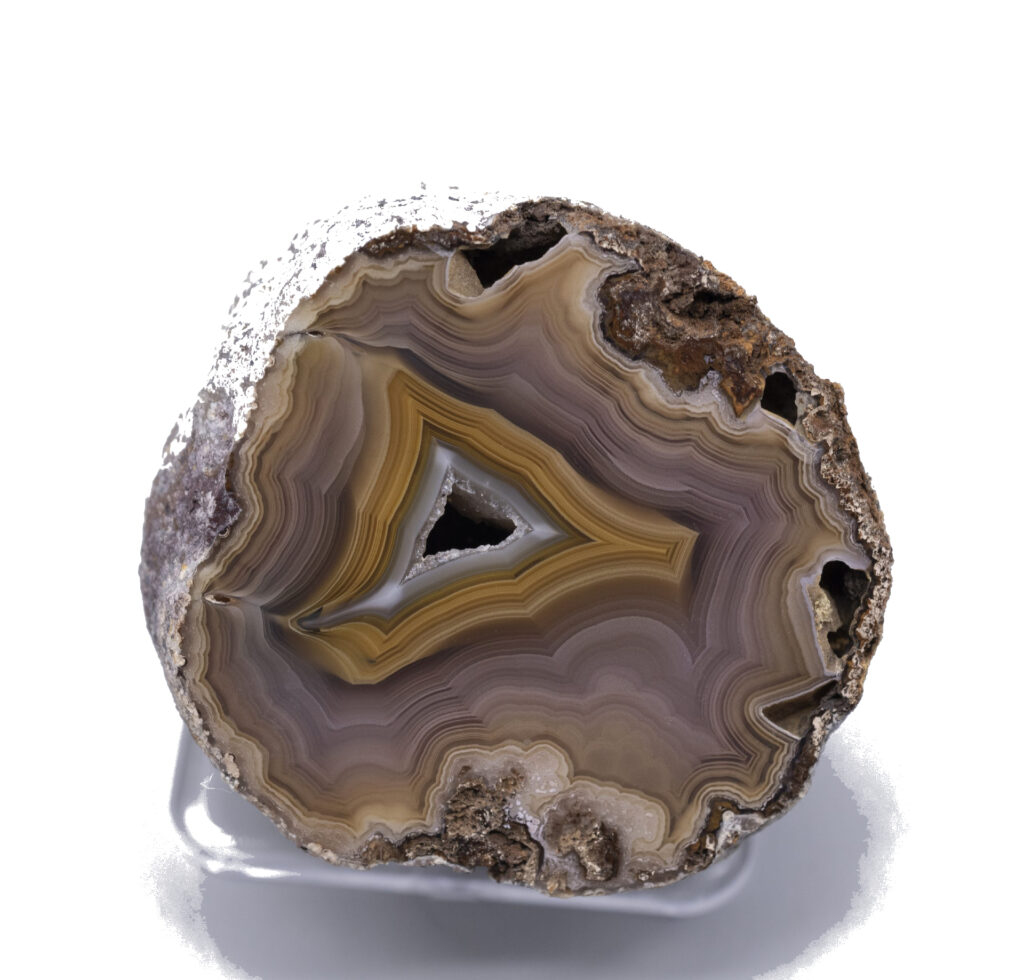
This article explores Coyamito agate in detail, covering its geological origins, distinctive features, formation process, global significance, and various uses.
Geological Origins of Coyamito Agate
Coyamito agate is found in the volcanic regions of Chihuahua, Mexico, specifically on the Coyamito Ranch, located near the famous Ojo Laguna Ranch, where the equally renowned Laguna agate is found. This region is part of the Northern Mexican agate belt, which is known for producing some of the most striking and collectible agates in the world. These agates formed millions of years ago during the Tertiary period, as volcanic activity in the region created the perfect conditions for agate formation.
Volcanic Activity and Agate Formation
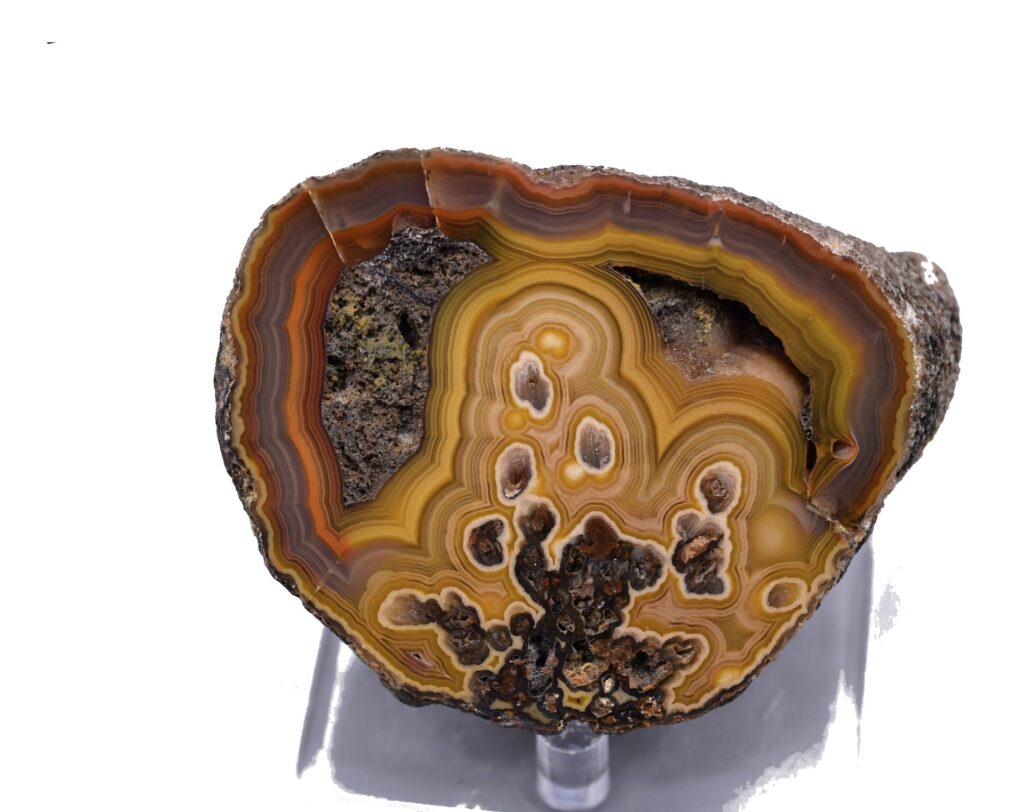
The agates of this region, including Coyamito, were formed in gas bubbles (vesicles) within volcanic rocks, such as rhyolite and basalt, created by volcanic eruptions. As the molten lava cooled and hardened, it trapped gas bubbles, leaving behind cavities. Over time, silica-rich water from the surrounding environment seeped into these cavities. The silica, combined with various trace elements and minerals, gradually crystallized into chalcedony, forming the beautiful bands that characterize agate.
The unique conditions present in this region, including the specific mineral content of the groundwater, the temperature, and the pressure at the time of formation, contributed to the distinct colorations and banding patterns of Coyamito agate. These factors also played a role in the formation of the complex, multi-layered structures for which this agate is famous.
Distinctive Features of Coyamito Agate
Coyamito agate is highly regarded for its variety of colors, intricate patterns, and the presence of unique formations such as pseudomorphs, sagenite inclusions, and “fortification” structures. The following features distinguish Coyamito agate from other types of agate:
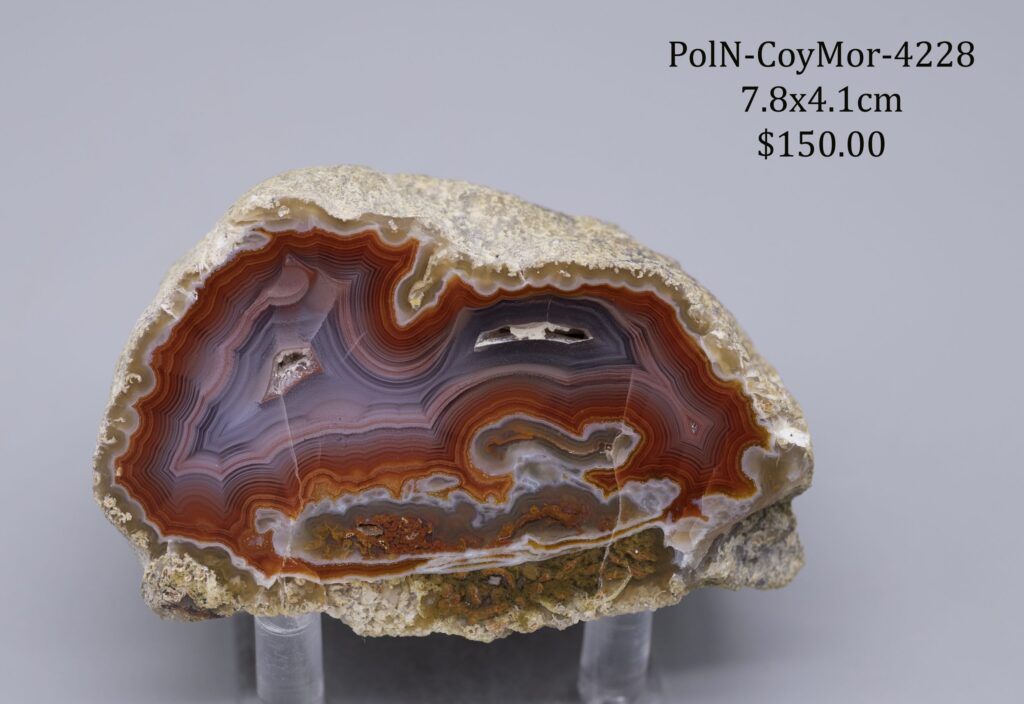
1. Color Range
Coyamito agate is known for its rich, vibrant color palette. Common colors found in Coyamito agates include reds, oranges, pinks, purples, yellows, and whites. These colors result from the presence of various mineral impurities within the silica, such as iron oxides (reds, oranges), manganese (purples), and other trace elements. The sharp contrasts between these colors within the banding give Coyamito agate its striking visual appeal.
2. Banding Patterns
The banding in Coyamito agate is typically very well-defined, with sharp, angular bands forming concentric circles or more complex geometric patterns. These banding structures are often reminiscent of fortification agate, where the bands mimic the walls of a fortress, creating a multi-dimensional, layered appearance.
Coyamito agates also sometimes exhibit a “shadow” effect within the bands, where certain layers are translucent and allow light to pass through, giving the agate a three-dimensional depth. This characteristic is particularly prized among collectors.
3. Pseudomorphs and Inclusions
One of the rare and fascinating features of Coyamito agate is the occurrence of pseudomorphs—structures where one mineral replaces another while retaining the original shape. For instance, in some Coyamito specimens, quartz may replace calcite, preserving the crystal shapes but transforming them into a new mineral.
In addition to pseudomorphs, some Coyamito agates contain sagenite inclusions—delicate, needle-like formations of minerals such as goethite or rutile. These inclusions create intricate, web-like patterns within the stone, adding to its complexity and beauty.
4. Eye Formations
Another striking feature of Coyamito agate is the presence of “eye” formations, where the bands form circular or oval shapes that resemble eyes. These eye structures are particularly prominent in some Coyamito specimens and are highly sought after for their unique appearance. The eyes are often surrounded by complex banding, further enhancing the stone’s aesthetic appeal.
5. Crystal and Geode Formations
Occasionally, Coyamito agates may form geodes—hollow agate nodules lined with crystals. The crystals are typically quartz or amethyst and add another dimension of beauty to the already striking agate. These geodes, when sliced open, reveal the stunning internal banding alongside the crystal-lined cavity, making them particularly desirable among collectors.
Formation Process of Coyamito Agate
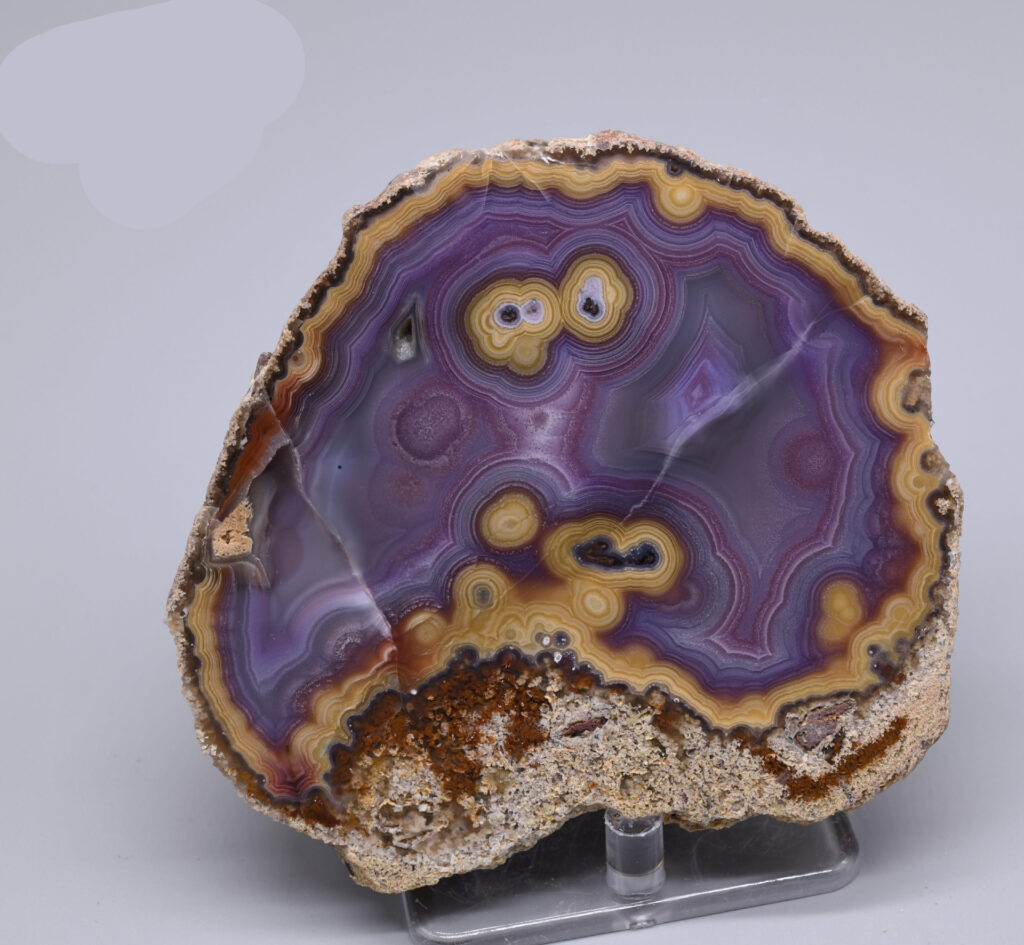
The formation of Coyamito agate follows the same basic principles as other agates but with specific regional variations that contribute to its unique features.
- Initial Lava Formation: The volcanic activity in the region produces molten lava that solidifies into rocks such as rhyolite or basalt. As the lava cools, gas bubbles become trapped within the rock, forming vesicles.
- Silica Deposition: Over time, silica-rich groundwater seeps into these vesicles, carrying with it dissolved minerals. The silica gradually deposits in layers, forming the chalcedony that makes up the agate. The trace minerals present in the groundwater determine the colors and inclusions that develop within the agate.
- Banding Development: As the silica is deposited in layers, periodic changes in the mineral composition of the solution lead to the formation of distinct bands. The sharp, angular banding seen in Coyamito agate may be the result of changes in pressure, temperature, or the availability of minerals during the formation process.
- Final Crystallization: In some cases, after the agate bands have formed, the cavity may remain partially open, allowing for the growth of quartz or amethyst crystals. These crystals grow inward from the walls of the cavity, forming geodes that contain both banded agate and crystalline formations.
Geographic Significance
Coyamito agate is exclusively mined in Chihuahua, Mexico, on the Coyamito Ranch. The region’s geological history and unique volcanic activity have made it one of the most important agate-producing areas in the world. The agates from this region are often compared to those found on neighboring Ojo Laguna Ranch (Laguna agates) due to their similar formation processes and appearance. However, Coyamito agates tend to have more intricate pseudomorph formations and sagenite inclusions, which set them apart.
Uses of Coyamito Agate
Coyamito agate is prized for a variety of reasons and has a wide range of applications, from ornamental use to scientific study.
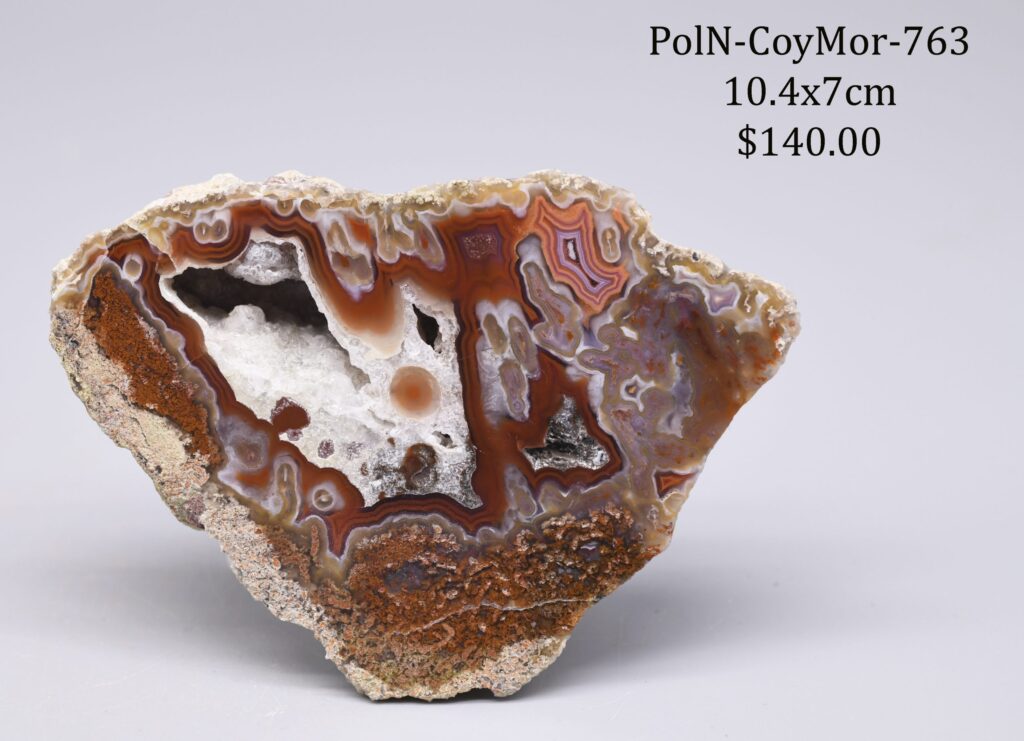
1. Jewelry Making
The vibrant colors and striking patterns of Coyamito agate make it a popular choice for jewelry. The agate is often cut into cabochons and used in rings, pendants, earrings, and other decorative pieces. Due to the durability of agate (with a hardness of 6.5 to 7 on the Mohs scale), it is well-suited for jewelry that can be worn daily without significant risk of damage.
2. Collector’s Items
Coyamito agate is highly valued among mineral and gemstone collectors due to its rarity and the diversity of its patterns. Collectors seek out specific features, such as well-defined banding, sagenite inclusions, and pseudomorphs. High-quality specimens, especially those with unique formations, can fetch high prices in the gem and mineral market.
3. Lapidary Arts
In addition to jewelry, Coyamito agate is used in the lapidary arts to create a variety of decorative objects, including carved sculptures, polished slabs, and display pieces. The intricate patterns and colors of the agate make it a popular choice for lapidary artists looking to create one-of-a-kind pieces.
4. Scientific Study
Coyamito agate, like other agates, provides valuable information to geologists and mineralogists about volcanic activity and mineral formation. The study of agate banding, inclusions, and pseudomorphs can offer insights into the geological history of the region in which the agate was formed. In addition, the presence of certain minerals within the agate can provide clues about the composition of the original volcanic rock and the environmental conditions during agate formation.
Care and Maintenance of Coyamito Agate
Although Coyamito agate is a durable stone, it still requires proper care to maintain its beauty and prevent damage.
- Avoid Harsh Chemicals: Exposure to strong chemicals, such as bleach or cleaning agents, can damage the surface of the agate. It’s important to avoid contact with household cleaners or other harsh substances.
- Clean Gently: To clean Coyamito agate, use a soft cloth or brush with mild, soapy water. Avoid using ultrasonic cleaners, as the vibrations can cause fractures in the stone.
- Store Properly: To prevent scratches, Coyamito agate jewelry should be stored separately from harder gemstones, such as diamonds. Use soft pouches or fabric-lined boxes to protect the stone from accidental damage.
Conclusion
Coyamito agate stands out as one of the most unique and sought-after varieties of agate due to its vibrant colors, sharp banding, and rare inclusions. Its origins in the volcanic regions of Chihuahua, Mexico, lend it a distinct geological significance, while its aesthetic appeal makes it highly prized among collectors and jewelry makers. Whether admired for its beauty or studied for its geological importance, Coyamito agate remains one of the most captivating members of the agate family.




































